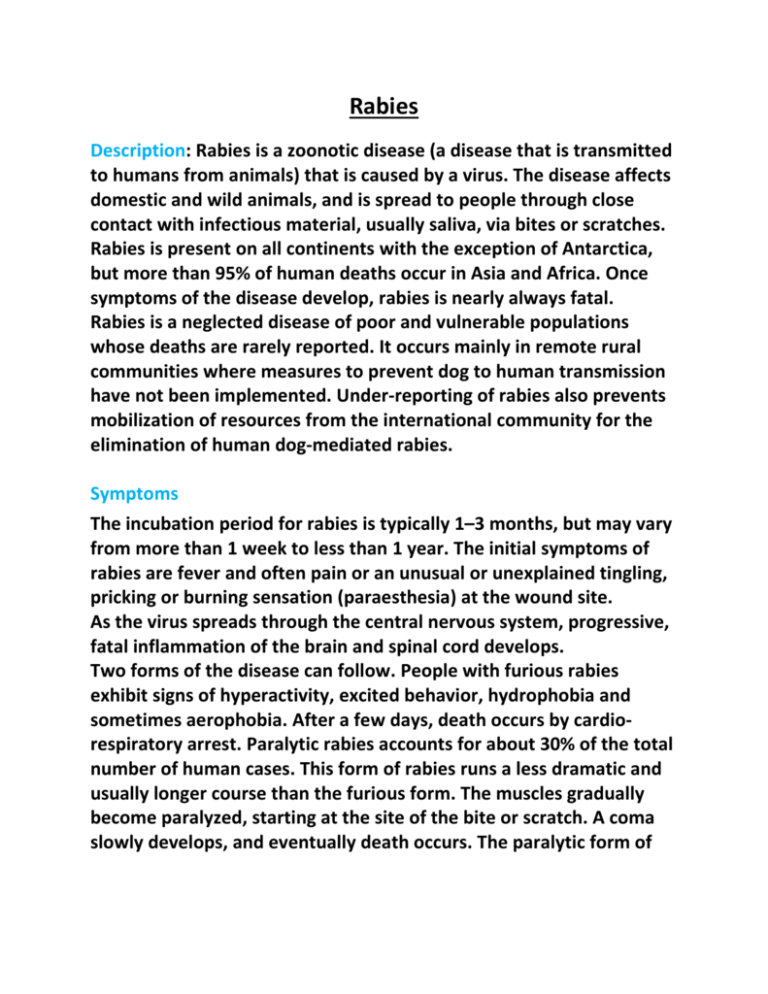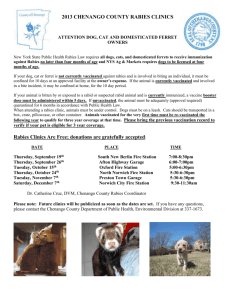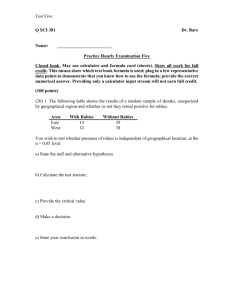Rabies
advertisement

Rabies Description: Rabies is a zoonotic disease (a disease that is transmitted to humans from animals) that is caused by a virus. The disease affects domestic and wild animals, and is spread to people through close contact with infectious material, usually saliva, via bites or scratches. Rabies is present on all continents with the exception of Antarctica, but more than 95% of human deaths occur in Asia and Africa. Once symptoms of the disease develop, rabies is nearly always fatal. Rabies is a neglected disease of poor and vulnerable populations whose deaths are rarely reported. It occurs mainly in remote rural communities where measures to prevent dog to human transmission have not been implemented. Under-reporting of rabies also prevents mobilization of resources from the international community for the elimination of human dog-mediated rabies. Symptoms The incubation period for rabies is typically 1–3 months, but may vary from more than 1 week to less than 1 year. The initial symptoms of rabies are fever and often pain or an unusual or unexplained tingling, pricking or burning sensation (paraesthesia) at the wound site. As the virus spreads through the central nervous system, progressive, fatal inflammation of the brain and spinal cord develops. Two forms of the disease can follow. People with furious rabies exhibit signs of hyperactivity, excited behavior, hydrophobia and sometimes aerophobia. After a few days, death occurs by cardiorespiratory arrest. Paralytic rabies accounts for about 30% of the total number of human cases. This form of rabies runs a less dramatic and usually longer course than the furious form. The muscles gradually become paralyzed, starting at the site of the bite or scratch. A coma slowly develops, and eventually death occurs. The paralytic form of rabies is often misdiagnosed, contributing to the under-reporting of the disease. Diagnosis No tests are available to diagnose rabies infection in humans before the onset of clinical disease, and unless the rabies-specific signs of hydrophobia or aerophobia are present, the clinical diagnosis may be difficult. Human rabies can be confirmed intra-vital and post mortem by various diagnostic techniques aimed at detecting whole virus, viral antigens or nucleic acids in infected tissues (brain, skin, urine or saliva). Transmission People are usually infected following a deep bite or scratch by an infected animal. Dogs are the main host and transmitter of rabies. They are the source of infection in all of the estimated 50 000 human rabies deaths annually in Asia and Africa. Bats are the source of most human rabies deaths in the Americas. Bat rabies has also recently emerged as a public health threat in Australia and Western Europe. Human deaths following exposure to foxes, raccoons, skunks, jackals, mongooses and other wild carnivore host species are very rare. Transmission can also occur when infectious material (usually saliva) comes into direct contact with human mucosa or fresh skin wounds. Human-to-human transmission by bite is theoretically possible but has never been confirmed. Rarely, rabies may be contracted by inhalation of virus-containing aerosol or via transplantation of an infected organ. Ingestion of raw meat or other tissues from animals infected with rabies is not a source of human infection. History Rabies has been reported in historical documents since about 2300 BC. Ancient texts recorded that owners of rabid dogs were cautioned against getting bitten. The word rabies is derived from the Latin word rabies, which meant "madness or rage." For many centuries, it was common practice to kill any animal or human that showed symptoms of the disease because tradition had taught people that the disease could be easily passed on to other people and isolation or death of the afflicted could prevent transmission of the disease. In the 15th century, Italian physician Girolamo Fracastoro studied rabies and concluded that it was a communicable disease transmitted to people by direct contact with saliva from infected animals. He termed the disease rabies. In 1895, after studying the data presented by Fracastoro centuries before, Louis Pasteur and Emile Roux were able to produce a vaccine against the disease-causing viruses without actually discovering or isolating the viruses. Rabies has been a problem in many countries, even into the 21st century as China developed a "one-dog" rule for people in Beijing to better control an increasing rate of dog rabies in 2006. Although the U.S. has had no people infected by dogs in years, there is an increasing incidence in wild animals (for example, bats and raccoons), especially in the southern states since the 1970s. The virus that causes rabies is Lyssavirus (Lyssa is the Greek goddess of madness, rage, and frenzy) rabies, a cylindrical or bullet-shaped virus that is enveloped and contains a negative-sensed RNA that makes up its genetic material. Figure 2: CDC diagrams of the bullet-shaped rabies virus. The top image is the longitudinal view, and the bottom image is the cross-sectional view of the viral structure Bibliography World Health Organization. (2013, July). Rabies. Retrieved October 14, 2013, from World Health Organization. Bibliography Medicine Net. (2012, April 18). Rabies. Retrieved October 14, 2013, from Medicine Net. World Health Organization. (2013, July). Rabies. Retrieved October 14, 2013, from World Health Organization.

